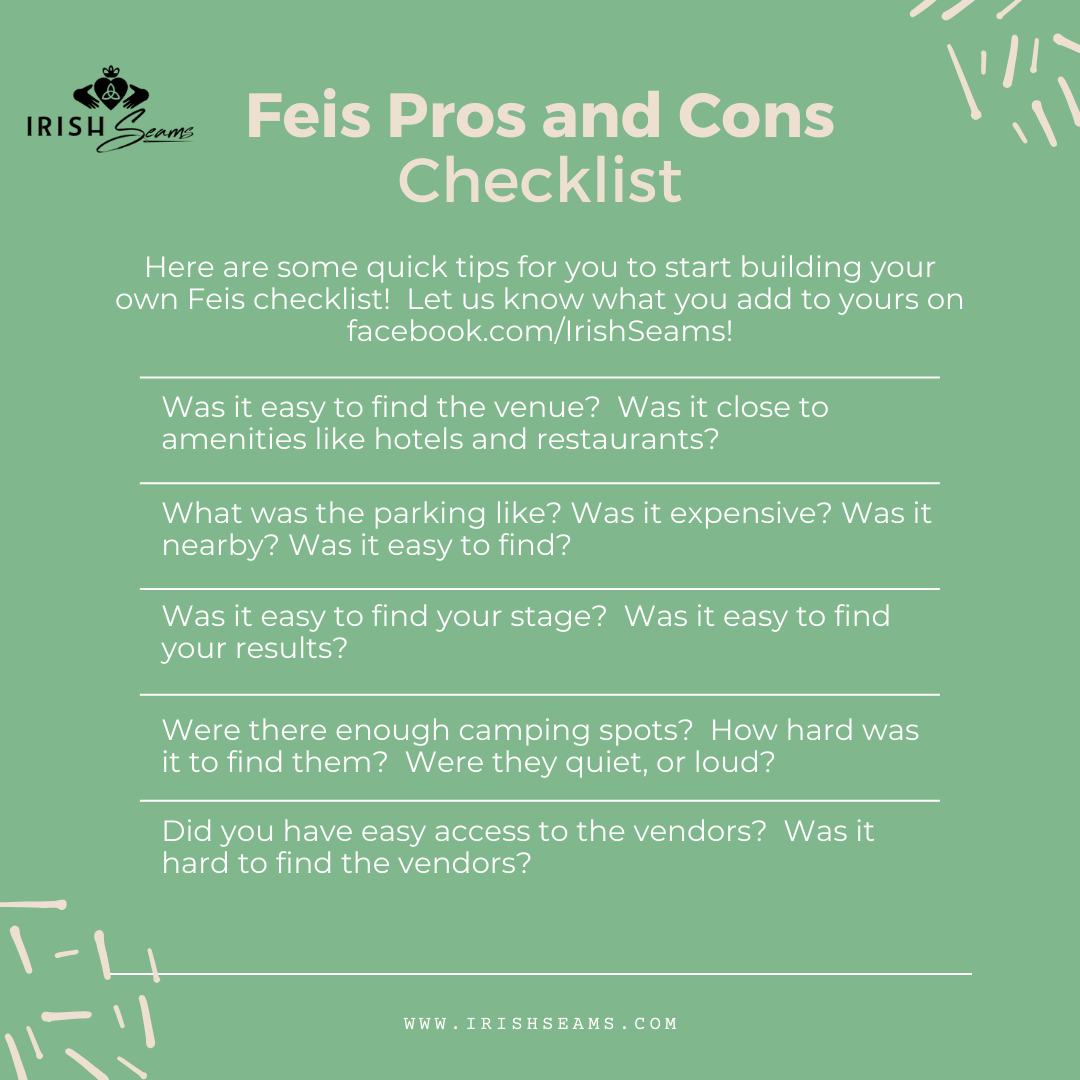
There’s no denying it, Irish dance is an expensive hobby. There’s the costumes, the shoes, the lessons, the travel, and then feiseanna on top of all that. It can add up quickly in little- or sometimes quite large- chunks. So how can you save money while still doing Irish dance? In this series of articles, we’ll be sharing our tips and tricks for getting the most bang for your buck and saving money without having to stop dancing.
We’ll be focusing on one of the bigger expenses in this sport- feiseanna. Feiseanna are expensive. But you probably still want to go to them, because they’re an important part of Irish dance. So how can you reduce the impact on your wallet?
1: Picking your feiseanna.
A major factor is picking out feiseanna that don’t charge as much. There are a few trends to consider in that- bigger feiseanna with regional pull tend to charge a bit more for example, and so do feiseanna that are attached to fancy venues full of bells and whistles like theme parks. On the other hand, a really small local feis might need to charge a bit more to cover their bills as well. There isn’t one good rule of thumb for how to find which events are more affordable, so we encourage you to look up as many feiseanna in your area as you can find and compare their prices. The registration fees will usually be listed on the feis syllabus or the registration website. It’s worth seeing if you can coordinate with other dancers and parents to see what prices have been like before, as well.
Another part of saving money on feis expenses is to set a limit on how many feiseanna you want to go to in a year. This seems obvious, but it bears stating anyway. Giving yourself a sort of ‘budget’ of how many feiseanna you want to attend and sticking to it can help make sure you don’t lose track of how much you’ve put into the sport in a year and whether you stayed on track for your monthly budget.
A great way to keep track of this- and determine which feis you want to go to again in the future- is to keep a feiseanna notebook. A lot of people already keep notes of how their dancer placed at each event they’ve gone to, but you should go beyond that! Note down the pros and cons of each feis after they’re done so you can remember what it was like more clearly next time you register. Were the bathrooms close to the seating? Were you able to find everything easily? How expensive were concessions?
Here’s some of the things we take note of whenever we go to a feis. There are a lot more things to consider of course, including some that are mostly just issues for vendors like how easy it is to haul all of our stock in, but this list is a good base to start adding things to.
And we would love to hear your take on this kind of list! Are there things you would add, things you would get rid of? How do you usually rank the importance of the things you note down? Let us know how you customize your feis pros and cons on our facebook page!
2: Pay registration fees early.
This might seem counterintuitive in an article about saving money on Irish dance, but it is very important that you pay your feis registration fees early. Ideally, you should pay as soon as you register. There are two reasons you should do this:
A: A lot of people forget, but there are late fees associated with feis registration. A lot of places will let you register as late as the day before the feis begins or even the day of the event… but you’re going to be paying an extra $50 or more if you do. The registration fees start low and rise over time, so pay them early and have some more money for souvenirs!
B: This is a bit more of a PSA: if too many people register without paying, or even if not enough people register at all, the feis might not happen. If the feis committee doesn’t get the number of paid registrations they need to cover the cost of running the feis, they may need to cancel the feis. Feis organizers can’t rent a space, get material for stages, and arrange for a set of judges and musicians to fly out and run a stage the night before the feis starts. If they don’t get enough from registration fees the money needed to run the feis might just not be there. And a lot of the time if they have to cancel the feis they’ve already spent the registration money they did get and then some, putting a serious financial burden on the organizers.
It’s been happening more often lately, because people are understandably hesitant to spend. You can help prevent it- and help keep feiseanna as a whole alive- by paying your registration fees early.
3: Cutting your losses.
It doesn’t always work out. Maybe you do pay your fee and the feis gets canceled. Or perhaps something comes up and you’re just not able to attend- it could be anything from car trouble to family illness to the feis venue being hit by a tornado. You might be able to come up with some last-minute workarounds, but if you’re not careful that can add a lot of additional costs. Sometimes it’s better to accept that it’s not going to work out this time. If you get in contact with the organizers, you can usually get a free spot in the next year’s feis if you paid your fee and can’t attend for whatever reason. It won’t put money back in your pocket, but it means you haven’t wasted it either. And, after all, the feis registration is only a part of your overall expenses when attending a feis- there’s food, lodging, and travel to consider as well. We’ll cover those in other articles, but the bright side here is even if you can’t get the registration fee back you still probably have the bulk of the money you set aside for this feis still in hand.
4: Consider costuming.
An extremely expensive part of Irish dance- possibly the most expensive part- is the costumes. Especially for solo dresses, which can have price tags higher than some used cars. So how to mitigate those costs?
Well, blackout costumes. A simple black skirt, bloomers, and top or leotard- available in a ready-to-go package from our webstore– along with the standard dance shoes comes in at a much more reasonable price point, and technically you can wear them to compete at any feis. But it does need to be said, that may hurt your odds. Like it or not, the bright colors, big hair, and shiny gemstones are part of what a lot of judges expect.
However, there does seem to be a growing trend of ‘blackout’ feis- events where dancers are supposed to wear their blackout costumes. Traditionally this was only common for outdoor feis or other events where there’s a terrifying chance of getting your solo dress dirty, but they’re growing a bit more common as time goes on. These feiseanna are a great pick for dancers who still aren’t sure about going all the way to a full solo dress, allowing them to dance relatively inexpensively while still being on an even playing field.
5: Location
This is a big one, and we’ll be covering elements of it in future articles. The physical location of the feis you go to is going to have a huge effect on the overall cost of going to that event. Here are some broad guidelines to consider when looking at which feis you want to attend:
A feis you can drive to from your home will always be cheaper than a feis you have to get a hotel room for.
A feis in a big city will have more expensive rooms, but there will almost always be rooms near the event.
A feis in a small town will have cheaper rooms, but might run out as the event gets closer.
At the same time, there are only going to be so many feiseanna right next door to you. Everyone has their own limit of how far they’re willing to go for a feis, and we’d like to hear yours on facebook!
That’s all for now, folks! Keep an eye on our site for more articles like this coming soon!


